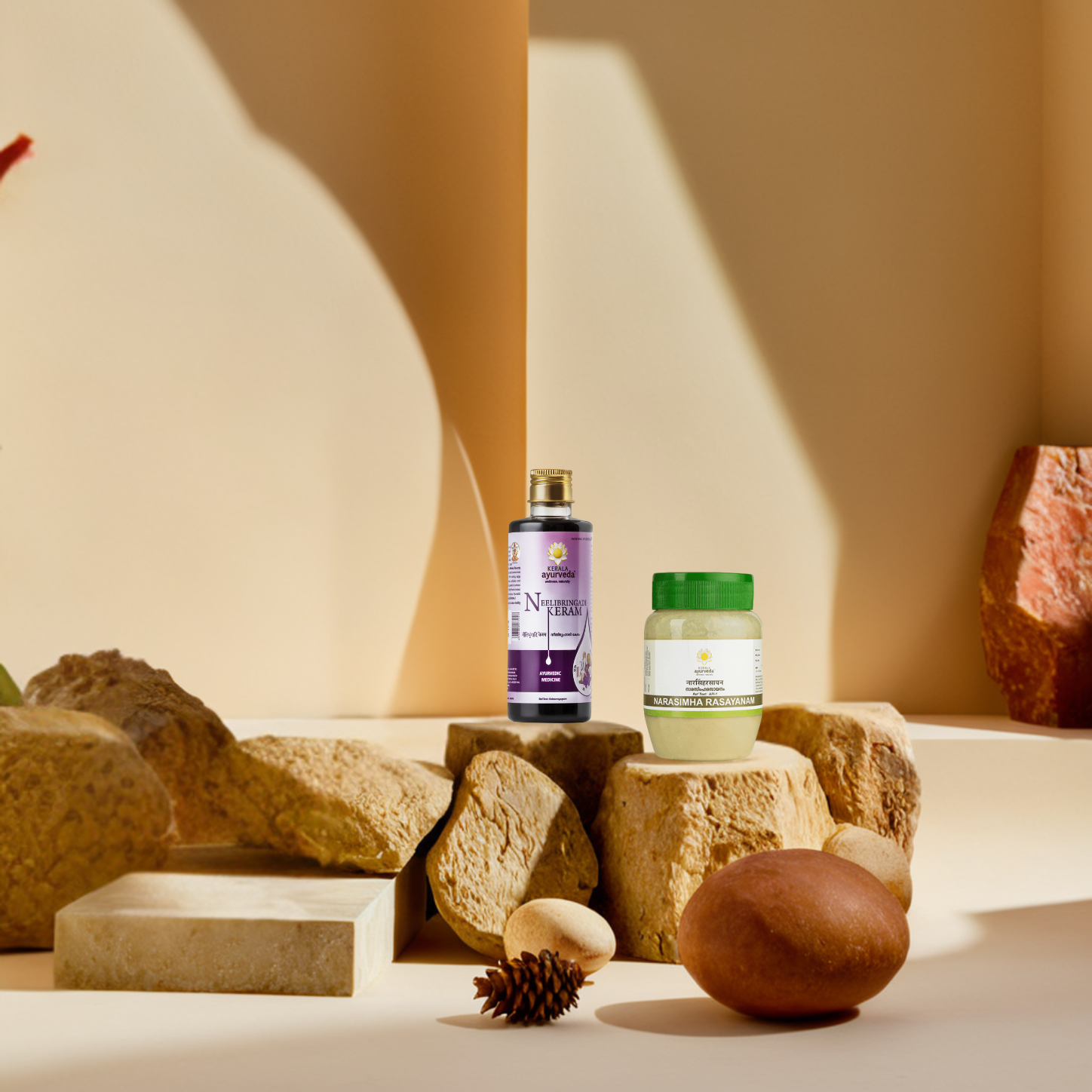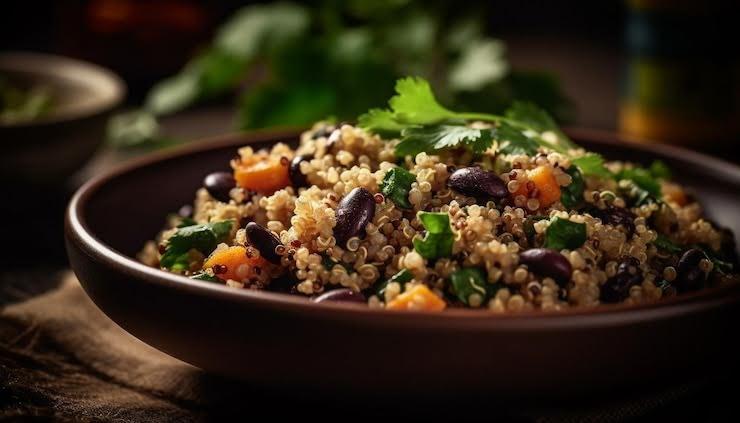Highlights
Njavara Rice (pronounced as nyah-va-rah) is also known as Shashtika Shali in Sanskrit. It is truly unique, especially when it comes to Ayurveda. Grown mainly in Kerala, this special variety of rice isn’t just a staple food; you can call it a powerful healer. In fact, Ayurveda swears by it for its incredible health benefits.
One of the most popular therapies using it is called Njavara Kizhi. It’s basically a warm poultice made from the rice that's applied to the body, which helps flush out toxins, improve blood circulation, and ease sore muscles.
But that’s just the beginning. Njavara Rice is packed with antioxidants, supports digestion, gives your energy levels a nice lift, and even helps maintain healthy-looking skin. In Ayurvedic terms, it’s all about restoring balance between your Vata, Pitta, and Kapha, while deeply nourishing your body and mind.
What is the Importance of Rice in Indian History and Culture?
Rice has always been a big part of Indian life. It appears everywhere, from our kitchens to our festivals and even in our oldest scriptures, the Yajurveda and Rigveda. It’s not just food; it’s seen as sacred, a symbol of life, prosperity, and abundance.
Think about festivals like Onam, Pongal, or Bihu; they all revolve around the rice harvest. We’ve got age-old customs too, like offering rice to the gods, or tossing it over newlyweds to bless them with good luck and plenty. Even a baby’s first solid food, during the annaprashana ceremony, is usually rice cooked in milk. It’s just one of the many ways rice is woven into our culture.
And it’s not just us. Around half the world relies on rice as a daily staple. It’s been grown for thousands of years, some say since 6500 years ago, and over time, we’ve seen all kinds of varieties pop up. Grown mostly in warm, tropical climates, rice is packed with energy, fiber, a bit of protein, and essential minerals. No wonder it’s the most widely grown grain across the globe!
But among all the rice varieties we’ve grown and loved over the years, one truly stands out for its healing benefits and deep Ayurvedic roots: Njavara rice.
What is Njavara Rice as per Ayurveda?
Njavara rice is quite unique. It grows fast and is ready in just sixty days, which is where it gets its name, “Sashti,” the Sanskrit word for sixty. In Kerala, people fondly call it Njavara, and it’s easy to see why. This humble grain may look simple, but as per Ayurveda, it’s a hidden gem celebrated for its remarkable healing benefits.
What makes Njavara stand out is how gentle it is on the body. It’s easy to digest, has a naturally sweet taste, and balances all three doshas: Vata, Pitta, and Kapha. Because it’s unpolished, it retains all its goodness, which makes it ideal for Ayurvedic treatments. Farmers in Kerala even call it “gold” because of how valuable it is both in terms of health and tradition.
There are two types of Sastika or Njavara rice: one is white, and the other is more of a blackish-white. The white one is considered the best. Njavara has been used for centuries, especially to support the muscles and strengthen the immune system. And during the monsoon season, it plays an important role in a nourishing dish called Karkidaka kanji or Marunnu kanji. This rice gruel is cooked with herbs and is a part of a traditional Ayurvedic routine to boost immunity and help the body cleanse and recover during the rainy months.
Njavara rice, however, is too costly because it grows only in certain regions and doesn’t produce a large yield. But its rarity, combined with its incredible health benefits, makes it totally worth it. No wonder people call it “gold with fragrance”; it’s rare, precious, and packed with powerful healing capabilities.
How Ayurveda Values Njavara Rice for Its Healing Power?
Ayurveda has been talking about the benefits of rice for centuries. In fact, ancient texts mention something called Suka Dhaanya, which is basically a category of dry grains that includes rice. These are further grouped into Sali and Vrihi, and out of all the Vrihi types, Njavara stands out as the best. It even gets a special mention in the Ashtanga Hridaya, one of Ayurveda’s classic texts.
What’s interesting is that people say Njavara rice grown in higher regions is even more powerful. And recently, it earned a Geographical Indication (GI) tag, which just proves how unique and valued it is. This rice has been around for over 2000 years, and that’s no accident; its health benefits are that impressive.
With its strong Ayurvedic roots, Njavara is more than just a grain; it’s a trusted part of natural wellness, helping the body stay nourished, balanced, and healthy naturally.
What are the Health Benefits of Njavara Rice?
Njavara rice isn’t just tasty; it’s also packed with health benefits that make it a go-to in Ayurvedic medicine. It’s known for its healing properties and can help with everything from digestion to skin health. Njavara rice has earned its reputation as a natural powerhouse and offers many benefits:
- Improves lactation when made into a gruel with milk.
- Good weaning food for infants, especially those with low birth weight, as it helps with healthy weight gain.
- Packed with Vitamin C and helps boost the immune system.
- Rich in antioxidants and promotes overall health.
- Higher in protein and fiber than other rice varieties, and supports digestion.
- Contains flavonoids and oryzanol, which have anti-inflammatory properties.
- Known as the "rice that heals," and helps in internal healing.
- Njavara rice paste is effective in treating psoriasis and skin lesions.
While Njavara rice is packed with nutrients that support your body from within, its magic doesn’t stop at the dinner table. This grain also shines in external therapies that have been practiced in Ayurveda for centuries.
What are the Therapeutic Uses of Njavara?
In Ayurveda, Njavara rice is used in two popular treatments: Njavara Kizhi and Njavara Theppu. In Njavara Kizhi, the rice is cooked with herbal decoctions and cow’s milk, then wrapped in soft cloth bundles called boluses. These are dipped in warm herbal mixtures and gently massaged over the body.
Njavara Theppu is a milder version, great for kids or older people who might not be comfortable with too much heat. Instead of using boluses, a warm rice paste made with herbs is applied straight to the skin, followed by a soothing massage.
Both treatments are incredibly soothing, great for the skin, and especially helpful for joint pain, arthritis, and nerve-related issues. Njavara Theppu, along with simple daily use of Myaxyl Oil or a few drops of Gandha Thailam, can gently support the body’s healing process. If you're looking for a natural way to ease joint or nerve discomfort, this kind of routine might be worth trying.
And beyond its healing role in Ayurvedic therapies, Njavara rice also brings comfort to the kitchen as a nourishing ingredient.
How to Cook a Healthy Recipe with Njavara Rice?
If you’ve got some Njavara rice at home, you’re all set to make something truly special. This rice isn’t just packed with health benefits; it also makes a really comforting meal. One of the easiest and tastiest ways to enjoy it is by making Paal Kanji, a warm rice gruel that’s light, soothing, and full of flavor. It’s perfect for days when you want something simple, nourishing, and easy on the stomach.
Ingredients
Here’s what you’ll need to make this delicious and wholesome Paal Kanji. It’s simple, soothing, and perfect when you want something light but nourishing:
- Njavara rice (½ cup): This is the heart of the dish. It gives the gruel a soft, slightly sticky texture and provides all those Ayurvedic health benefits.
- Milk (½ cup): Adds a creamy, comforting richness that makes the dish feel more complete.
- Water (3 cups): Helps cook the rice down to just the right consistency. Feel free to adjust based on how thick or thin you like it.
- Salt (as per taste): Just a little pinch to bring all the flavors together.
- Grated coconut (1 tbsp): Adds a hint of sweetness and a bit of texture that pairs beautifully with the rice.
- Cumin seeds (½ tsp): Brings in a warm, earthy flavor and helps with digestion too.
Procedure
Making Paal Kanji is pretty easy, and it cooks up quickly. Here’s how to make it:
- Wash the Njavara rice and soak it for about 30 minutes.
- Drain the water, then add the rice and 3 cups of fresh water to a pressure cooker.
- Cook it for 3 whistles, then let it simmer for another 5 minutes.
- Once the pressure releases, open the lid, give it a good stir, and lightly mash the rice.
- Add the milk and let it cook for a few more minutes until it thickens to your liking.
- In a small pan, roast the cumin seeds and grated coconut until they smell nice and toasty.
- Mix this into the gruel, add salt to taste, and give it one final stir.
- Serve hot, and if you want to make it a full meal, pair it with a simple green gram dish like Cherupayar Thoran.
And there you have it: a warm, nourishing bowl of Paal Kanji, packed with the goodness of Njavara rice.
Conclusion
Njavara Rice isn’t just another grain on your plate; it’s something truly special. From the lush fields of Kerala to Ayurvedic healing rooms, this rice has earned its place as a trusted companion for health and wellness.
Whether you're trying out a warm bowl of Paal Kanji on a rainy day or experiencing a relaxing Njavara Kizhi therapy, you’re tapping into centuries of tradition and natural goodness. It’s gentle, nourishing, and full of benefits that go way beyond just food. That’s why they call it “gold with fragrance.”
Kerala Ayurveda brings you closer to this tradition with authentic herbal oils and wellness products that help support your body and mind, naturally, every day.
FAQs
1. Is Njavara rice the same as red rice?
Yes, Njavara rice is a type of red rice. It is a unique variety traditionally grown in Kerala and known for its medicinal properties as per Ayurveda.
2. Is Njavara rice good for diabetes?
Yes, Njavara rice is relatively safe for diabetics due to its lower Glycemic Index. Unlike white rice (GI ~75), Njavara rice has a GI closer to 60, which means it causes a slower rise in blood sugar.
3. Is Njavara rice good for babies?
Yes, Njavara rice is ideal for babies, especially during the weaning phase. Its low Glycemic Index ensures slow digestion, keeping babies fuller for longer and aiding steady energy release.
4. Which is the healthiest type of rice?
Brown rice, black rice, and red rice (including Njavara) are among the healthiest types of rice. Brown rice helps regulate blood sugar and supports metabolism, black rice has antioxidant properties that may fight cancer, and red rice aids heart health and reduces inflammation.





